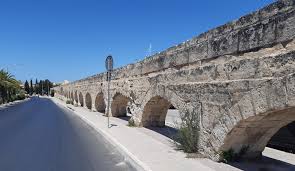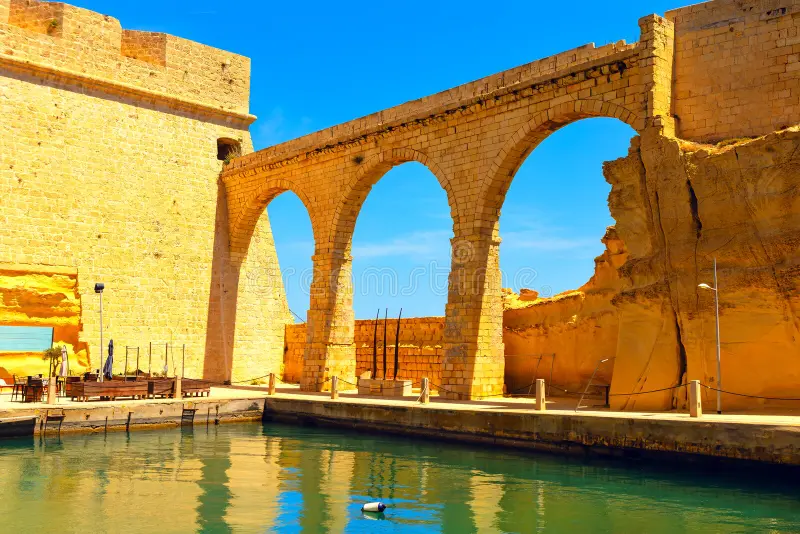Table of Contents
ToggleAquadotts in Malta
When people in Malta refer to aquadotts, they are almost always speaking about the historic aqueduct systems that once carried fresh water across the islands. The term aquadotts is a localised and informal version of aqueducts. These structures form an important part of Maltese engineering history and remain visible reminders of the island’s need to secure reliable access to clean water. For centuries Malta lacked substantial natural freshwater sources, so the development of aqueducts was essential for supporting urban growth, agricultural activity and public health.
Although aqueducts have existed in various forms since antiquity, the most recognisable in Malta are the early modern structures built primarily during the rule of the Knights of Saint John. These aqueducts helped transform Valletta and surrounding towns into thriving urban centres.

Water Scarcity and the Need for Aqueducts
Malta’s geographic position and geological makeup meant that groundwater was always limited. While wells and natural springs existed, they were not dependable enough to support the growing population. As Valletta expanded during the sixteenth and seventeenth centuries, the need for a stable urban water supply became increasingly urgent. The Knights, who had invested heavily in fortifications, hospitals and public buildings, required a water system that could reach the new capital city with enough volume to sustain both residents and military operations.
This challenge led to the design of long distance aqueducts that could transport water from inland areas where natural springs were more reliable. These constructions became some of the most ambitious civil engineering projects undertaken on the islands.
The Wignacourt Aqueduct
The most famous and best preserved aquadott in Malta is the Wignacourt Aqueduct. Commissioned by Grand Master Alof de Wignacourt and completed in the early seventeenth century, it stretched from the Rabat and Dingli area all the way to Valletta. This system carried water using a combination of underground channels, elevated arches and storage structures.
Its characteristic arches, still standing in places such as Santa Venera and Birkirkara, are among the most iconic pieces of Maltese heritage architecture. The aqueduct relied on a gentle gradient so that water could flow naturally by the force of gravity. This required exceptionally careful surveying and construction skills at a time when equipment was far more limited compared to modern engineering tools.
The Wignacourt Aqueduct supplied water to fountains, cisterns and public facilities in Valletta and Floriana. It enabled improved sanitation and supported the further development of these districts. The structure remained active for several centuries before eventually becoming obsolete with the introduction of modern pumping stations and water mains.

Other Aqueduct Systems and Related Infrastructure
Aquadotts in Malta also include smaller or less visible systems built during different periods. Some medieval and early modern channels, known as qanats in other regions, were carved underground to tap into natural aquifers. In the nineteenth century, British engineers carried out additional works to stabilise and expand the island’s water supply. These projects did not always produce monumental arches but instead consisted of tunnels, reservoirs and pipelines.
Even before large scale aqueduct construction, Maltese communities relied heavily on cleverly engineered cisterns cut into the rock. Many traditional houses and palaces still contain these cisterns, and they demonstrate how the islands have long adapted to limited rainfall and porous limestone.
Architectural and Cultural Significance
Malta’s aquadotts are admired not only for their function but also for their aesthetic and cultural importance. The surviving arches illustrate the craftsmanship of masonry specialists who shaped each block of local limestone by hand. The rhythmic sequence of arches stretching across the landscape evokes both elegance and strength.
These structures also represent a moment when Malta was part of a wider European movement of early modern engineering. They reflect the ambitions of the Knights of Saint John, who saw infrastructure as essential to transforming Valletta into a cosmopolitan capital comparable to major cities on the continent.
Beyond their architectural value, the aqueducts serve as a reminder of the social history of water in Malta. Access to clean water shaped daily life, influenced where people settled and contributed to improvements in public health. Understanding these aqueducts allows contemporary audiences to appreciate how earlier generations solved urgent practical problems through design and long term planning.
Preservation and Heritage Efforts
The remains of the Wignacourt Aqueduct and other water related structures require ongoing conservation. Exposure to weather conditions, urban development and the natural fragility of limestone makes them vulnerable to damage. Conservation bodies in Malta have recognised the importance of safeguarding these features and incorporating them into educational and cultural programmes. One organisation that provides historical information about the aqueducts is Heritage Malta.
Restoration projects often involve cleaning the stonework, reinforcing weakened areas and preventing further deterioration while maintaining the authentic character of the original construction. Public awareness campaigns and heritage trails encourage residents and visitors to engage with these landmarks not simply as historical curiosities but as vital chapters in the story of Maltese resilience.



Aquadotts in Malta are far more than old stone arches. They are testimony to centuries of ingenuity in the face of environmental challenges. These aqueducts supplied the capital with essential fresh water, supported the growth of urban life and showcased the engineering ability of the Knights. Their presence today enriches the Maltese landscape and offers a tangible link to a past in which water was both precious and difficult to secure. Understanding their history helps illuminate the broader narrative of how the islands adapted to their natural limitations and built enduring solutions that still inspire admiration.




